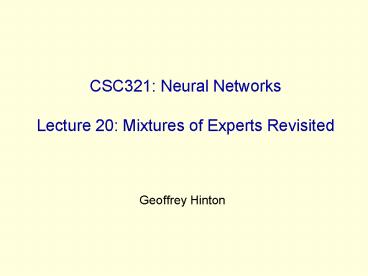CSC321: Neural Networks Lecture 20: Mixtures of Experts Revisited - PowerPoint PPT Presentation
Title:
CSC321: Neural Networks Lecture 20: Mixtures of Experts Revisited
Description:
But how do we partition the dataset into subsets for each expert? ... This fraction is the posterior probability of expert i. What are vowels? ... – PowerPoint PPT presentation
Number of Views:120
Avg rating:3.0/5.0
Title: CSC321: Neural Networks Lecture 20: Mixtures of Experts Revisited
1
CSC321 Neural NetworksLecture 20 Mixtures of
Experts Revisited
- Geoffrey Hinton
2
A spectrum of models
- Fully global models
- e. g. Polynomial
- May be slow to fit
- Each parameter depends on all the data
- Very local models
- e.g. Nearest neighbors
- Very fast to fit
- Just store training cases
- Local smoothing obviously improves things
y
y
x
x
3
Multiple local models
- Instead of using a single global model or lots of
very local models, use several models of
intermediate complexity. - Good if the dataset contains several different
regimes which have different relationships
between input and output. - But how do we partition the dataset into subsets
for each expert?
4
Partitioning based on input alone versus
partitioning based on input-output relationship
- We need to cluster the training cases into
subsets, one for each local model. - The aim of the clustering is NOT to find clusters
of similar input vectors. - We want each cluster to have a relationship
between input and output that can be well-modeled
by one local model
I
I/O
which partition is best, I or I/O?
5
The mixture of experts architecture
- Combined predictor
- Simple error function for training
- (There is a better error function)
Expert 1 Expert 2 Expert 3
Softmax gating network
input
6
The derivatives of the simple cost function
- If we differentiate w.r.t. the outputs of the
experts we get a signal for training each expert. - If we differentiate w.r.t. the outputs of the
gating network we get a signal for training the
gating net. - We want to raise p for all experts that give less
than the average squared error of all the experts
(weighted by p)
7
Another view of mixtures of experts
- One way to combine the outputs of the experts is
to take a weighted average, using the gating
network to decide how much weight to place on
each expert. - But there is another way to combine the experts.
- How many times does the earth rotate around its
axis each year? - What will be the exchange rate of the Canadian
dollar the day after the Quebec referendum?
8
Giving a whole distribution as output
- If there are several possible regimes and we are
not sure which one we are in, its better to
output a whole distribution. - Error is negative log probability of right answer
70c 75c
364.25 366.25
9
The probability distribution that is implicitly
assumed when using squared error
- Minimizing the squared residuals is equivalent to
maximizing the log probability of the correct
answers under a Gaussian centered at the models
guess. - If we assume that the variance of the Gaussian is
the same for all cases, its value does not matter.
y models prediction
d correct answer
10
The probability of the correct answer under a
mixture of Gaussians
Mixing proportion assigned to expert i for case c
by the gating network
output of expert i
Prob. of desired output on case c given the
mixture
Normalization term for a Gaussian with
11
A natural error measure for a Mixture of Experts
This fraction is the posterior probability of
expert i
12
What are vowels?
- The vocal tract has about four resonant
frequencies which are called formants. - We can vary the frequencies of the four formants.
- How do we hear the formants?
- The larynx makes clicks. We hear the dying
resonances of each click. - The click rate is the pitch of the voice. It is
independent of the formants. The relative
energies in each harmonic of the pitch define the
envelope of a formant. - Each vowel corresponds to a different region in
the plane defined by the first two formants, F1
and F2. Diphthongs are different.
13
A picture of two imaginary vowels and a mixture
of two linear experts after learning
decision boundary of expert 1
decision boundary of gating net
F2
decision boundary of expert 2
F1































